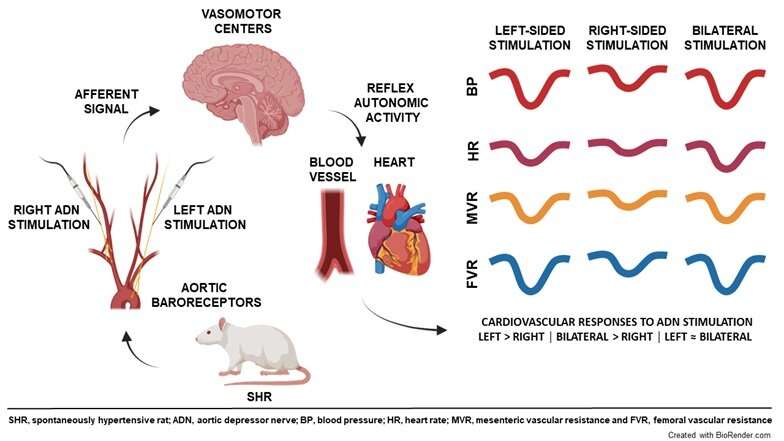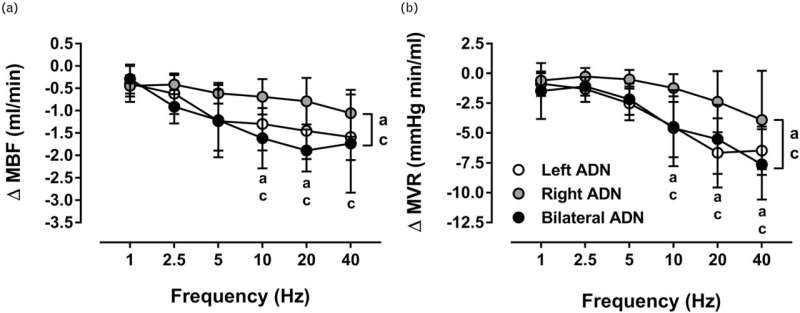June 19, 2023 feature
This article has been reviewed according to Science X's editorial process and policies. Editors have highlighted the following attributes while ensuring the content's credibility:
fact-checked
peer-reviewed publication
trusted source
proofread
Investigating the laterality of blood pressure regulation during cardiovascular disease progression

The outcomes of blood pressure regulation provide a clear picture of the underlying mechanisms of the arterial baroreflex, a critical cardiovascular reflex, during health and disease. Under normal blood pressure, the functional difference can vary between the left vs. right aortic baroreceptor, a type of mechanoreceptor or special nerve ending used to relay information derived from blood pressure within the autonomous nervous system, and regulate blood pressure within a preset range. Nevertheless, much is unknown regarding the laterality or dominance of left vs. right regions of aortic baroreflex function under high blood pressure.
To answer this question, Ibrahim Salman, Omar Ameer and an international team of scientists in pharmacy, bioelectronics and medicine at the Alfaisal University, Saudi Arabia, Case Western University, U.S., and the U.K., studied the impact of laterality on baroreflex-driven cardiovascular reflexes. They accomplished this by using a genetic model of essential hypertension—the spontaneously hypertensive rat. The research outcomes of the study are now published in the Journal of Hypertension.
Key highlights of the study
The research team noted that by stimulating the left, right and bilateral aortic depressor nerve in the animal model, they could evoke frequency-dependent decreases in the mean arterial pressure, heart rate, mesenteric vascular resistance and femoral vascular resistance in the animal model. Primary author Ibrahim Salman said, "At first glance, the body is bilateral and looks symmetrical on both sides. But this first impression is quite deceptive, especially since it comes to functionally relevant differences between the left and right sides of the brain."
Their work showed the occurrence of greater reflex reductions during left and bilateral aortic depressor nerve stimulation, when compared with right-sided stimulation, to indicate a left-side dominance. Ibrahim said, "This latest publication from the team shares new insights on how the left side of the 'aortic' baroreflex pathway outperformed the right side to contribute greater reflex reductions in blood pressure in an experimental model of hypertension."
Moreover, in the animal model of interest, the reflex depressor responses were primarily driven by changes in vascular resistance. The study outcomes highlighted the shared similarity of lateralization in the aortic baroreflex function under both normotensive and high blood pressure (hypertensive) conditions.
Mechanisms of blood pressure regulation
Blood pressure can be maintained by the arterial baroreceptor reflex as a crucial regulatory mechanism functioning within a relatively narrow fluctuation range. Synchronal action of the reflex pathway can restore baseline blood pressure levels by promoting arterial vasodilation and reduced cardiac output. Impaired baroreflex function and sympathetic hyperactivity are associated with the pathway of chronic hypertension. Advanced methods in bioengineering and medicine have allowed biologists to precisely detect and modulate the patterns of electrical signaling within the nervous system, which has led to therapeutic clinical interventions to treat hypertensive patients. Nevertheless, much remains to be known of the anatomical and functional components of the arterial baroreflex to impact cardiovascular disease progression during hypertension.

Baroreflex activation therapy (BAT) technology
Salman and colleagues electrically activated the baroreceptor afferent fibers in the aortic depressor nerve in rats to explore physiological and pathological mechanisms underlying the baroreflex-driven regulation of cardiovascular function. Their work showed that direct electrical stimulation of the baroreceptor afferents in spontaneously hypertensive rats has significant scope to analyze the baroreceptor circuit's role during hypertension to identify new targets underlying blood pressure regulation and thereby discover new methods to enhance or improve baroreflex activation therapy (BAT) technology. The scientists showed that the aortic baroreceptor afferents were viable alternative neuromodulation targets to carotid baroreceptor stimulation (a trajectory previously examined in clinical research) to lower mean arterial pressure in the preclinical rodent model.
Study design and outcomes
Existing reports supporting anatomical and functional differences in the left versus right baroreflex pathways are limited under normal as well as pathological conditions such as hypertension. The study outcomes highlighted the left-right symmetry during circulatory functions in the rodent model to obtain data traces illustrating cardiovascular responses during nerve stimulation. Alongside calculations of the percentage changes in hemodynamic measures. The research team also measured the reflex depressor responses, reflex bradycardic responses, reflex mesenteric and reflex femoral vascular responses in total.
The work showed that the functional characterization of aortic baroreflex during hypertension allowed the left and right aortic baroreflex systems to behave differently, where their interactions with each other were not specifically additive. The outcomes agreed with previous work conducted by the same team under normotensive conditions to emphasize side-selection of the aortic baroreflex function during hypertension, as well.
Previous studies with patients suggest similar side-selection in the carotid baroreflex function. Salman and colleagues therefore envision that the side-selection observed with aortic baroreflex in animal models in this study would similarly imply in clinical outcomes. These findings are suited specifically for the aortic baroreflex, and therefore can inform current surgical practices of the bilateral implantation of a baroreflex activation therapy (BAT) device in patients.

Outlook and future perspectives
In this way, Ibrahim M. Salman, Omar Z. Ameer, and colleagues conducted functional characterization of the aortic baroreflex to show that comprehending these nervous system pathways is fundamental to fully understand a variety of systemic functions during health and disease. The results of this study showed left-right side-selection of the aortic baroreflex function to expand the knowledge of neuroanatomy and neurophysiology underlying an essential blood pressure regulatory mechanism.
The reported left-right asymmetry in baroreflex function opens a new and interesting possibility to appreciate the physiological function of this nerve fiber population that can be therapeutically targeted for neuromodulation. Baropacing is currently available for hypertensive and heart failure patients; therefore, the highlighted functional differences should contribute to the process of fine tuning the level of blood pressure drop in patients undergoing baroreflex activation therapy (BAT) and identify new neural targets for neuromodulation during clinical and preclinical investigations.
More information: Ibrahim M. Salman et al, Differential central integration of left versus right baroreceptor afferent input in spontaneously hypertensive rats, Journal of Hypertension (2023). DOI: 10.1097/HJH.0000000000003448
Omar Z. Ameer, Hypertension in chronic kidney disease: What lies behind the scene, Frontiers in Pharmacology (2022). DOI: 10.3389/fphar.2022.949260
© 2023 Science X Network


















